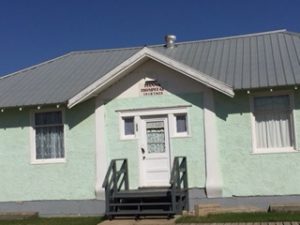Virtual Tour
That’s Not All…
This sums up the main street buildings, but that’s not all we have! There’s a windmill, a barn containing a two-headed calf, a blacksmith shop, and much more! If you’re a car fanatic, we’ve got you covered, as we have two buildings containing antique cars. Are you interested in typewriters? Maybe some old-style radios? Feel free to stop by for a tour!
St. Mary’s Evangelical Lutheran Church – 1910
Immigrants from Russia and Germany erected this church and laid out the adjoining cemetery 12 miles north of Delia. All the labour involved was volunteered; even the pews were hand-carved. This place of worship in a strange land served to bind the community into closer friendships with each other and God. Services were held in their native tongues until the 1950s when they began switching to English. The church struggled through the early days and the Depression, but in the 1960s, its doors closed for good. It wasn’t until 1969 that the church was moved to Museum grounds, serving as a fitting reminder of the past. The Historical Society has added the bell and front porch.
Canadian National Railway Station – 1920
No historical account of this area would be complete without including the railway story. The C.N.R. was the reason for the town being at this particular spot, and it even gave us the name Hanna, as David Blythe Hanna was the third president of the Canadian Northern Railway. At one point, it housed the Hammond family, which consisted of two parents and six daughters: Eva, Nellie, Francis, Edith, Dorthy, and Fanny. This very prominent Museum building was moved to Hanna from Pollockville (50 miles south of Hanna) in 1968 after being purchased for $1. In 1969, tracks were laid down in front of the station. The building was wholly repaired and filled with railway memorabilia. Since then, more items have been added, including a caboose!
Hanna Hospital – 1918
This building was Hanna’s first permanent hospital (usually called the Cottage Hospital), serving the town for four years. It was built by Mr. L. de Jurkowski for $5000 and stood between 3rd and 4th avenues, facing east. It opened its doors on June 1st, 1918, with a staff of two: Miss Keith and Miss Kate. This building could house 6-8 patients at one time; however, at one point in its history, it held 31 patients simultaneously due to the Spanish Influenza sweeping its way across the prairie. This building has been purchased and changed several times, but its resting place is the Museum grounds. Although the interior bears little resemblance to the original layout, the exterior is much the same. It has been fashioned to resemble what it would have looked like back then, complete with hospital beds, wheelchairs, and even an operating table.
Youngstown Jail – 1913
This jail cell is always an eye-catcher to visitors! It was originally located in Youngstown (35 miles east of Hanna) in their fire hall and ceased being used in 1961. Every artifact here has a story behind it, and this one is no exception. In 1929, there was a tale of a desperado escaping through the hole designed for the passing of food. This man successfully fled the police, hopped on a train, and was never seen again. Or was he? His daring feat is always a crowd-pleaser.
General Store – 1913
The General Store was opened in 1913 at Michichi, roughly 30 miles west of Hanna, by a C.N.R surveyor named G.W.M Boycott. This store served the town and surrounding area for 52 consecutive years. In 1915, it was sold to Dr. Johnson and his wife Pauline. When Dr. Johnson died in 1918, his wife and her brother Walter Murdock took over the store under Johnston & Co. General Merchants. It remained in the same hands until 1965, when it was shut down. In 1973, the building was moved to the Museum grounds. The store has been fashioned to resemble its glory days, with every shelf filled with items that would have been common back then.
Ranch House – 1912
The ranch house was built by Roy Herold on his homestead north of Stanmore (20 miles east of Hanna) and served as the family home for several generations. In 1968, it was donated to the Historical Society by Mr. Shields, who moved it to the museum grounds. Some minor repairs and additions, like the porch, were done to the building. The house has four rooms: a living room, kitchen/dining room, children’s bedroom, and a parent’s bedroom, which have all been furnished with artifacts typical of the homestead era. Each artifact has its own story behind it, so stop by to learn more about it!
Telephone Office -1929
The telephone office operated from 1929-1960 in Hanna. It stood on 2nd Avenue, west of the Royal Bank corner, and served as the telephone office until after 1960, when the Health Unit took ownership of the building. In 1971, the Royal Bank purchased the land for its new structure and donated the building to the Historical Society. Moving the building proved to be a struggle. It was necessary to remove the bricks and clean them before resetting them. In the process, many bricks were discovered to be unusable. As a result, new bricks were purchased, but the colour couldn’t be matched. This building has since been completely furnished and still has the switchboard used to connect calls. Along with the switchboard, this building features a hairdresser shop, a camera collection, and much more!








